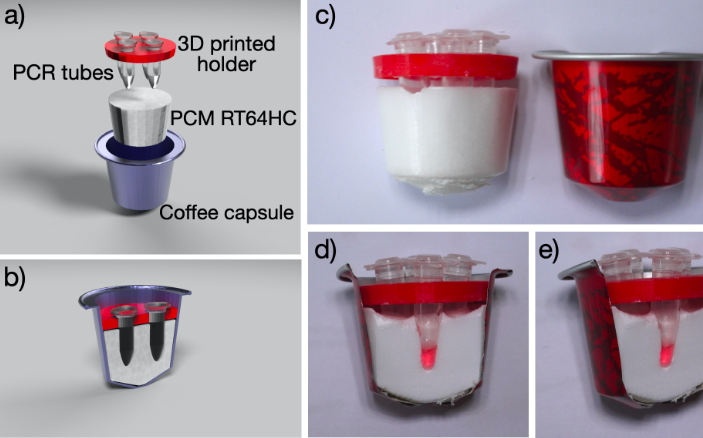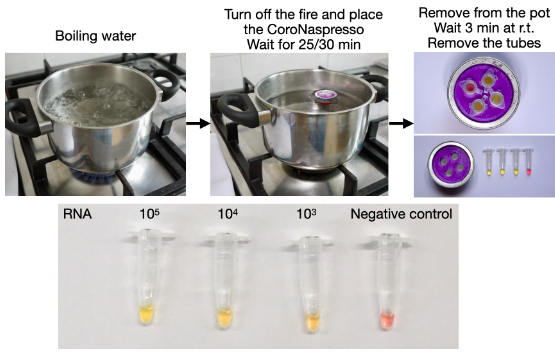Researchers based at the Dutch Wageningen University (WUR) have developed a COVID-19 home test kit that can be 3D printed and constructed for less than 20p.
Nicknamed ‘CoroNaspresso,’ the team’s device comprises coffee capsules that have been turned into mini chemical reactors, in which heated enzyme-loaded saliva vials change color to indicate the presence of COVID-19. By heating samples using Phase Changing Materials (PCMs) like cheap commercial wax, the scientists say their reusable kits could be ideal for boosting testing in developing countries.
“We designed a 3D printed plastic holder that fits four Eppendorf vials to perform the tests, and we get the results in just 30 minutes,” lead researcher Vittorio Saggiomo told Chemistry World. “The wax is like paraffin, it’s really cheap, the whole device costs under 20p. Moreover, the same capsule can be used many times, without generating any unwanted waste.”

Ramping-up COVID-19 testing
Since the onset of the global pandemic last year, governments across the globe have scrambled to establish testing, tracing and isolation regimes that prevent the spread of COVID-19. Although centralized testing centers have been erected in many countries, shortcomings in sample collection, storage and transport have prevented them from reaching a desired population screening threshold of 10%.
In the UK, for example, such a testing regime would require an unfeasible 6.6 million tests to be conducted every week, meaning that self-checking is becoming essential, especially for finding the asymptomatic infected. However, the standard SARS-CoV2 test is based on a Polymerase Chain Reaction (PCR), that’s far too complex for self-administration.
By contrast, Loop-mediated Amplification or ‘LAMP’ devices are much simpler, and use primers to selectively amplify part of the COVID-19 genome, detecting infections early-on. Commercial LAMP systems assess samples by heating them to 60-70°C, but results at home can be inconsistent, hence the team have now developed a novel device that’s triggered by a repeatable exothermic reaction.

Rustling up a CoroNaspresso
Having initially tested household appliances as a means of heating their samples, including an oven, dishwasher and washing machine, the scientists settled on Rubitherm RT64HC, a paraffin-based PCM. The low-cost wax has a melting temperature of 63-65°C, meaning that it can effectively be deployed to heat specimens at a consistent rate, and at a cost of around £11 per kilogram.
During testing, the researchers placed the affordable PCM inside their device, which consisted of four Nespresso coffee capsules and a 3D printed vial holder. Inside the vials, the team then loaded their samples with primers that were specifically designed to detect the E-gene region of COVID-19, and dunked them into boiling water for 25 minutes.
After allowing the samples to cool for three minutes, the scientists observed that the LAMP reaction had lowered their pH which caused them to turn a yellow-ish color, indicating a positive result. Within later experiments, the team leveraged their CoroNaspresso to retest three positive and negative patient samples, and the results matched those attained via the more expensive conventional PCR kits.
While the researchers successfully validated their approach, they acknowledged that it currently requires the use of complicated RNA-extraction steps before testing can begin. As a result, the Dutch team now intends to work towards developing an improved kit that’s capable of direct-saliva testing, as well as addressing other infectious diseases.
“It [the CoroNaspresso] is almost universal, as the only two things one would need to run the test are fire (or electricity) and water,” concluded the researchers in their paper. “Considering the design and required materials, it can be produced in millions within a short amount of time, with working production already in place.”
Rapidly 3D printed test kits
Over the last year, 3D printing has been deployed in various ways to help fight the global pandemic, including the production of PPE, ventilator parts and novel testing kits. At Carnegie Mellon University (CMU), for instance, researchers have leveraged Optomec’s Aerosol Jet Printing (AJP) technology to create 3D printed sensors, that are capable of detecting COVID-19 antibodies in just ten seconds.
Elsewhere, 3D printing service providers such as PrintParts have expanded on their existing supply chains to mass-produce nasopharyngeal (NP) swabs. The company opened a new production lab in Manhattan at the height of the pandemic early last year, enabling it to produce large quantities of swabs for use in New York City.
Since then, the The Food and Drug Administration (FDA) has issued updated guidance on the 3D printing of COVID-19 diagnostic devices, including NP swabs. The FDA advice essentially states that sterile swabs that don’t require premarket notification, will not need an EUA for distribution to occur, but must still be registered as 3D printed products.
The researchers’ findings are detailed in their paper titled “CoroNaspresso: A Cheap, Rapid and Simple Home Test for Nucleic Acid Amplification,” which was co-authored by Aldrik Velders, Michel Ossendrijver, Bart J.F. Keijser and Vittorio Saggiomo.
To stay up to date with the latest 3D printing news, don’t forget to subscribe to the 3D Printing Industry newsletter or follow us on Twitter or liking our page on Facebook.
Are you looking for a job in the additive manufacturing industry? Visit 3D Printing Jobs for a selection of roles in the industry.
Featured image shows a diagram of the scientists’ ‘CoroNaspresso’ COVID-19 test. Image via Vittorio Saggiomo.


